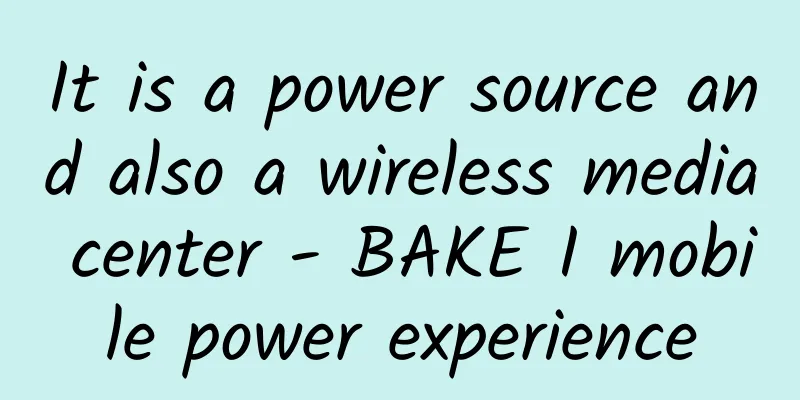It is a power source and also a wireless media center - BAKE I mobile power experience

|
Smartphones are becoming more and more like computers, and the development of television has also entered the Internet model. Now, more and more technological products no longer have a single role and purpose. The idea of integration, along with the advancement of technological means, has enabled many electronic devices to have the ability to "perform multiple roles." When it comes to mobile power banks, most consumers can only think of a portable charger that can charge mobile devices such as mobile phones and tablets, integrating power supply and charging functions. At most, some manufacturers will install LED lights on the body of the mobile power bank, so that the mobile power bank can act as a flashlight in certain occasions. But what kind of product will be born if you combine mobile power with terms such as "USB-OTG" and "Wi-Fi"? Recently, a mobile power called "BAKE I" was launched, which is such a multifunctional device. As a mobile power… BAKE I belongs to the category of mobile power, so naturally its appearance has the inherent characteristics of mobile power. In terms of packaging design, BAKE I's concept is similar to that of smartphone products. The primary-color cardboard packaging is opened and closed from top to bottom. The packaging contains the BAKE I product host, a charging data cable, a cloth cover for protecting the portable product, and some explanatory materials. It has everything it should have. The design of BAKE I itself is beautiful and reasonable. Although the power capacity reaches the "10,000-level" level of 10400mAH, the overall area of the machine is not much larger than the 4-inch iPhone. The thickness of the product is almost twice that of mainstream smartphones. It is not light and thin. For mobile power products, it can only be considered within an acceptable range. The BAKE I I got this time is the light blue version with a smooth glossy surface, which looks very stylish. At the bottom of the bottom of the machine, there is a square rubber part. This design makes BAKE I effectively anti-slip when placed horizontally on the desktop. In terms of power supply design, BAKE I can provide 5V 1A power output, which is enough to power most mobile devices. Unfortunately, in addition to the MicroUSB interface, there is only one standard USB power interface on the side of the body, and many available blank areas are not designed with anything. Whether from the number of charging devices of most consumers or the multi-port design of other competing products, this lacks humanization. In addition, BAKE I also supports the flashlight function that is common in current mobile power products. The LED bulb used for lighting is set on the side of the USB charging output port at the top of the product. The actual light is blue, which is slightly different from the generally warm light of smartphone flash. It is worth mentioning that although the switch on the top cover of the product is only responsible for controlling the state of the flashlight, and the harder key travel means there is almost no chance of accidental touch, the user needs to press and hold this button for about 2 seconds to turn the flashlight on and off. If the flashlight function is generally used in emergency situations, then I really don’t know what the considerations are for this design. As a wireless media center… To sum up, from the perspective of a mobile power bank, BAKE I performs quite well, but the real highlight of this product lies in its function as a wireless media center. Since BAKE I itself does not have storage function, to be precise, BAKE I is just a "medium" for building a "wireless media center" and a unit that sends out Wi-Fi signals. After the USB storage device is connected to BAKE I, the mobile device reads the contents of the USB storage device through the Wi-Fi network channel, which is equivalent to the mobile device realizing "wireless USB-OTG" with the help of BAKE I. In terms of hardware design, BAKE I has designed a physical Wi-Fi switch and a Reset button on the surface of the body, so that users can directly control the enabling and disabling of the "Wireless Media Center" function and save power when it is not necessary. It is relatively easy for new users to use the "Wireless Media Center" function. The instruction materials that come with BAKE I provide users with detailed instructions on how to use it, and explain them one by one for Android and Apple iOS users. As long as the user can understand the pictures and text, there will generally be no problems with the operation. In actual use, USB storage devices such as U disks need to be inserted into the USB port that is usually used for power output. This poses a problem. Again, because BAKE I is designed with only one standard-sized USB port, if the "Wireless Media Center" is used, then BAKE I cannot charge mobile devices. Conversely, it cannot connect to a U disk. An excellent product should not leave this kind of "decision" to consumers.
When it comes to reading the contents of USB flash drives, BAKE I's approach reflects humanized thinking. Users no longer need to install corresponding software apps on mobile devices. Taking the Android platform as an example, BAKE I recommends that users use the FTP function of the "ES File Explorer" in the instructions. After setting the corresponding parameters, the contents of the USB storage device connected to BAKE I can be read through the "iBake" folder on the mobile phone. The operation for Apple iOS platform products is similar. In principle, there is no problem in applying BAKE I's "Wireless Media Center" to other platforms such as Windows Phone or even PC. Unfortunately, users will encounter another "choice" during use. Before using BAKE I's "wireless media center" function, the mobile device must first connect to the Wi-Fi network called "iBAKE", which is the Wi-Fi network emitted by BAKE I. This means that in a Wi-Fi environment, users must first disconnect the Wi-Fi network used by the device to access the Internet. BAKE I cannot be integrated into the LAN environment like some smart home products. If the user wants to read the contents of the USB flash drive wirelessly through BAKE I, the mobile device in hand will temporarily be unable to access the Internet. Summarize: Apple's iPhone and iPad have never supported expandable storage, and the prices of high-storage space versions have always been high. Even for more open Android devices, from Nexus abroad to Xiaomi at home, the ban on "expansion cards" is ongoing. For users, the device storage space occupied by data content, mainly high-definition videos, is getting larger and larger. An external device that can realize similar OTG functions is very necessary in the real environment. The emergence of BAKE I can be said to combine the two necessities of contemporary mobile terminal devices, mobile power supply and OTG device, into one. Its practical value is obvious. But what cannot be ignored is that BAKE I still has a lot of room for improvement and improvement in design or function. Under the concept of product research and development with practical significance, perhaps the future BAKE II and BAKE III will be products that better meet user needs. As a winner of Toutiao's Qingyun Plan and Baijiahao's Bai+ Plan, the 2019 Baidu Digital Author of the Year, the Baijiahao's Most Popular Author in the Technology Field, the 2019 Sogou Technology and Culture Author, and the 2021 Baijiahao Quarterly Influential Creator, he has won many awards, including the 2013 Sohu Best Industry Media Person, the 2015 China New Media Entrepreneurship Competition Beijing Third Place, the 2015 Guangmang Experience Award, the 2015 China New Media Entrepreneurship Competition Finals Third Place, and the 2018 Baidu Dynamic Annual Powerful Celebrity. |
<<: Apple confirms new product launch event on September 9
>>: In-depth experience of Amazon overseas direct shopping: the things are really cheap!
Recommend
Cats’ common yet strange tricks really make them “cats”!
Leviathan Press: There has always been such a say...
5 Laws of Strategy | Use the first one and you can ignore the other four
Before formulating a communication strategy, mark...
0-year-old product manager: How to write a requirements document
[[156712]] As a new product person, after joining...
How much does it usually cost to make a mini program? Which mini program in the same city charges the lowest?
What is the general charge for making a mini prog...
Uncovering the secrets of Samsung’s empire: more than just selling phones
As you know, according to a report recently relea...
What is the difference between the 5 yuan and 25 yuan toothpaste in the supermarket? How to choose? Don't waste money anymore!
Many people may have seen promotions like this: t...
Strategies for promoting events and attracting new customers!
This article should have been written in the firs...
Can smart TV break the prediction of “TV will die”?
The widespread popularity of the Internet has bro...
The most powerful Zhihu promotion and drainage method in 2019
A few days ago, my famous Zhihu account in the sk...
A spider "resurrected from the dead" and turned into a claw machine in seconds? This study is a bit "weird and interesting"
A dead spider slowly descends, and then, suddenly...
Is it okay to lie down all the time during the holidays? Not necessarily
Produced by: Science Popularization China Produce...
Zhulu Diamond Exhibition - Crowd Tag Explosion Method
Zhulu Diamond Exhibition - Crowd Tag Explosion Me...
The beautiful temptation hidden in your home, don't bring it into your bedroom...
A few gorgeous flowers are dotted in her fluffy h...
Zhou Wen | "Come on" and "Strive for Excellence" for 40 Years
Since 1979, Zhou Wen, a professor born in the 196...
Tips for placing Tencent ads in the automotive industry
1. Industry prospects and current situation With ...









